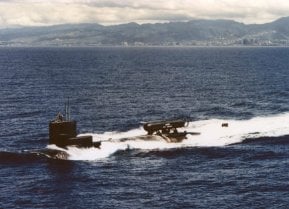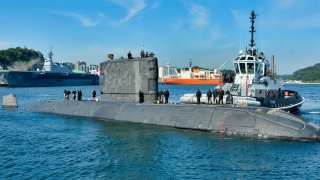Canada’s Submarine Nightmare Begins in the Arctic
It’s great to see Canada admit its navy needs significant modernization and expansion, especially in submarines. It remains to be seen, however, how Canada could ever develop such a submarine force in any meaningful timeline—if ever.
The race for the Arctic is heating up and Canada is feeling the burn. Since 2008, when the Russian government declared its intention to become the dominant Arctic power in the world, Moscow has moved with great alacrity toward achieving its goal—gaining significant advantages simply by dint of having been the first to invest in expanding a presence in the High North before any other great power took the threat seriously.

Only recently has Washington started waking up to the fact that the real Russian threat to the United States lies not in Europe but in the Arctic. Even more than the Americans, though, the Canadians, with their expansive border along the Arctic region, realize they’re being boxed out of their own backyard by the resurgent Russian bear.
To address the glaring capabilities gap between Russia and Canada, Ottawa has announced that they will be purchasing a dozen air-independent propulsion (AIP) submarines over the next decade to better deter the rising Russian threat in the High North.
Under the imprimatur of “Our North, Strong and Free,” the Trudeau government is putting forward a comprehensive strategy of deterrence as well as taking action to ensure continual access to Canada’s north.
A Bleak Situation for the Royal Canadian Navy
This is a necessary move by Ottawa, which has allowed for the Royal Canadian Navy’s (RCN) submarine force to atrophy. Currently, the RCN possesses only four aging Victoria-class submersibles. Three of these are permanently assigned to the distant Pacific Ocean and the fourth is nominally assigned to the Atlantic.
None of these systems are comparable in size or capability to the growing Russian presence in the Arctic.
Here's the issue, though. Several experts who’ve spoken to me for this story on condition of anonymity are highly skeptical that the Canadians will be able to move this ambitious program from paper to reality. The procurement process for Canada’s military—notably for extremely complex platforms, like submarines—is sclerotic and the bureaucratic hurdles are onerous.
What’s more, the projected timeline for the development and deployment of these submarines is so far into the future that it begs the question as to whether they’ll even be useful or not.
The Russians are Serious About Dominating the High North
After all, the Russians have dedicated an extreme amount of resources to securing their position in the Arctic and expanding it. Indeed, the Russians have deployed some of their most sophisticated warships and submarines to their Arctic holdings, while modernizing their bases throughout the region.
They have done this even as the Ukraine war demands increasing levels of resources and commitment from the Russian Armed Forces. And because of the Ukraine war, the Russian defense industrial base is humming at a feverish pace while most Western defense industrial bases—notably Canada’s—remain operating at a turgid pace.
Without a reliable, modern submarine force, the Canadian position in the High North will erode along with the melting ice sheet. Ottawa will become increasingly reliant on the United States Navy and Coast Guard to shore up its position.
Canada Cannot Compete Under Current Conditions
Yet, the U.S. Navy is also at its breaking point. Plus, while there is much commonality in the grand strategic aims of both Washington and Ottawa, the two have territorial disputes in the Arctic. In essence, Canada cannot rely upon the United States to take up for its lack of commitment and progress in the High North.
So, it’s great to see Canada admit its navy needs significant modernization and expansion. It remains to be seen, however, without immediate and serious reform of its defense industrial base as well as to its defense acquisitions programs, how Canada could ever develop such a submarine force in any meaningful timeline—if ever.
In the meantime, Moscow’s position in the High North is solidified and it will bring along its new pals in Beijing (which has an almost farcical delusion of being a “Near-Arctic” power (whatever the heck that really means).
About the Author
Brandon J. Weichert, a National Interest national security analyst, is a former Congressional staffer and geopolitical analyst who is a contributor at The Washington Times, the Asia Times, and The-Pipeline. He is the author of Winning Space: How America Remains a Superpower, Biohacked: China’s Race to Control Life, and The Shadow War: Iran’s Quest for Supremacy. His next book, A Disaster of Our Own Making: How the West Lost Ukraine, is due October 22 from Encounter Books. Weichert can be followed via Twitter @WeTheBrandon.
Image Credit: Creative Commons.


